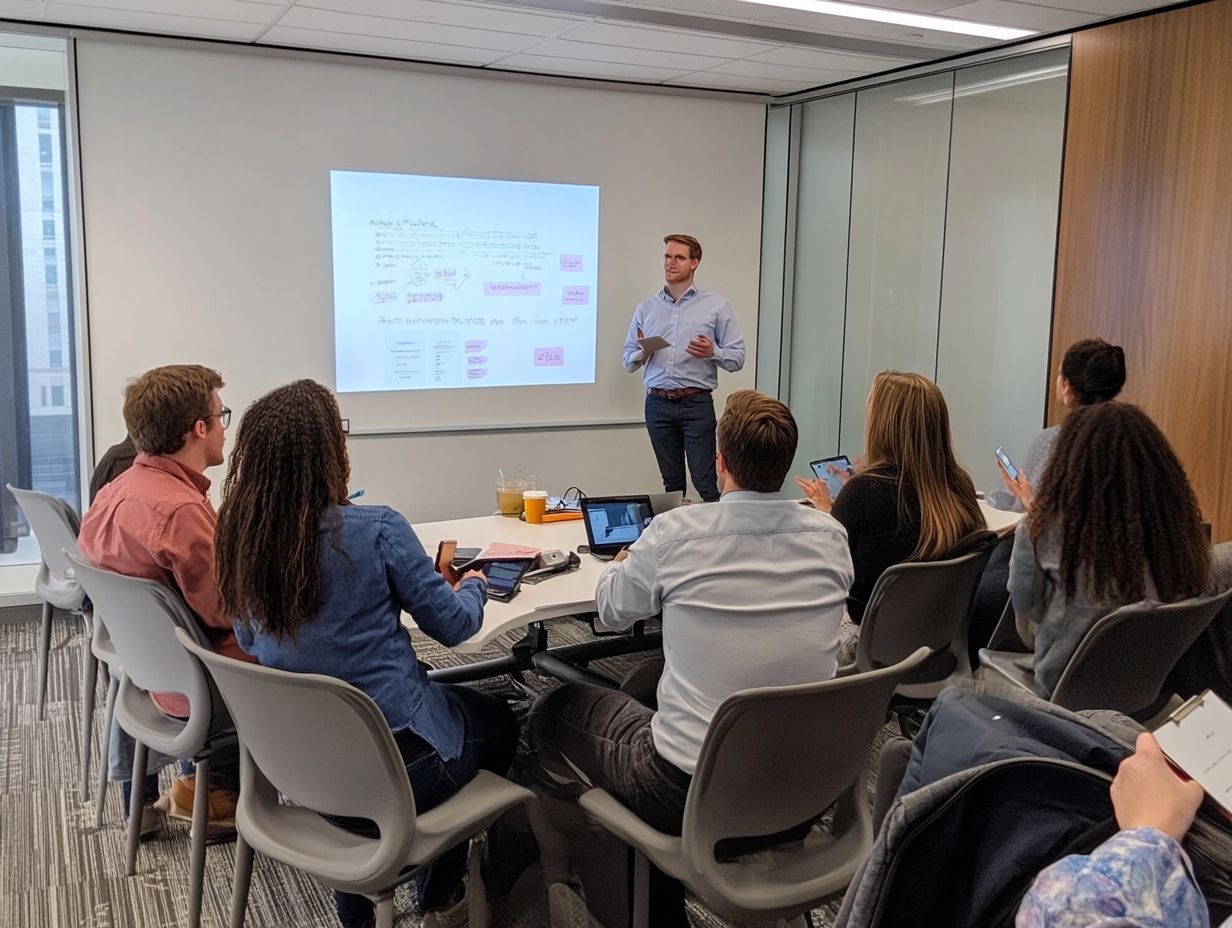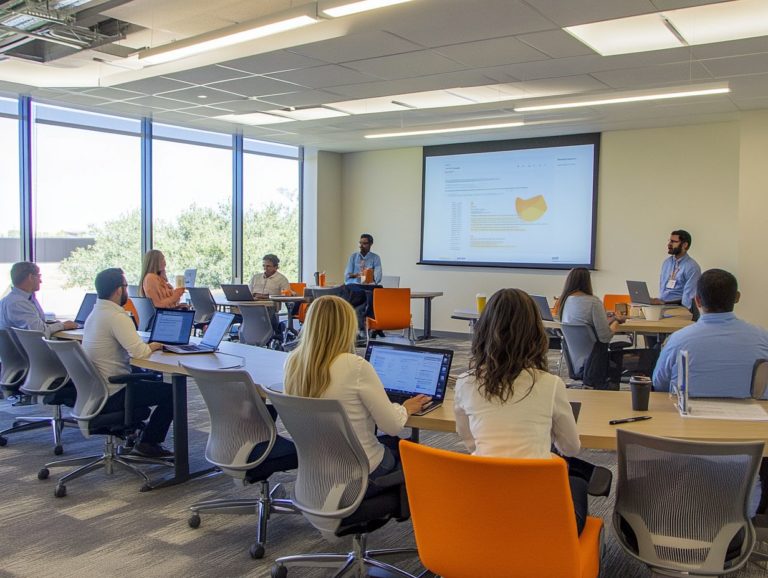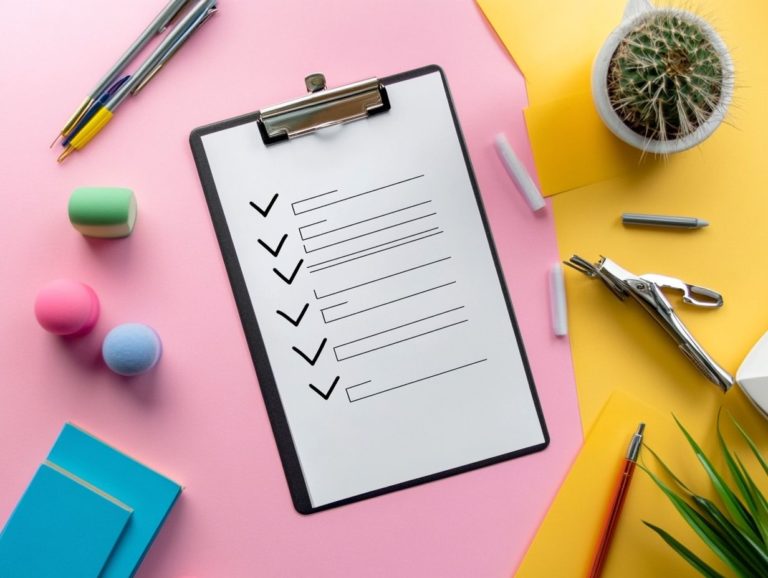5 Ways to Personalize Your Onboarding Program
Onboarding is far more than a mere formality; it serves as the cornerstone for a new hire’s journey within your organization. Discover five powerful strategies that will transform your onboarding program!
A personalized onboarding experience can profoundly influence employee satisfaction, engagement, and retention. You ll uncover the advantages of personalization, identify common pitfalls to avoid, and see how technology can elevate the process.
Immerse yourself in this exploration to transform your onboarding approach and pave the way for your new hires success.
Contents
- Key Takeaways to Personalize Your Onboarding:
- 1. Understand Your New Hires’ Needs and Goals
- 2. Create a Welcoming and Inclusive Environment
- 3. Tailor Training and Development to Individual Needs
- 4. Assign a Mentor or Buddy for Support
- 5. Continuously Gather Feedback and Make Adjustments
- Why Is Personalization Important in Onboarding?
- How Can Personalization Improve Employee Retention?
- What Are Some Common Mistakes to Avoid in Personalizing Onboarding?
- How Can Technology Help with Personalizing Onboarding?
- What Are Some Examples of Successful Personalized Onboarding Programs?
- Frequently Asked Questions
- What are the benefits of personalizing an onboarding program?
- How can personalization be incorporated into an onboarding program?
- What are some specific ways to personalize an onboarding program?
- Why is it important to personalize the onboarding experience?
- Can personalization be applied to a remote onboarding program?
- How can personalization help bridge the gap between a new hire’s skills and the job requirements?
Key Takeaways to Personalize Your Onboarding:

- Understand your new hires’ needs and goals to create a targeted onboarding experience.
- Foster a welcoming and inclusive environment to help new employees feel comfortable and valued.
- Personalize training and development to address individual needs and promote growth.
1. Understand Your New Hires’ Needs and Goals
Understanding the unique needs and goals of your new hires is essential for a successful onboarding process. This insight enables you to tailor your employee onboarding strategies effectively, enhancing engagement right from day one.
By leveraging onboarding software and HR software that is accessible online, you can efficiently gather vital information about each new hire s background, preferences, and career aspirations. This data gives you the power to create customized onboarding plans that genuinely resonate with their expectations and motivations.
Effective communication is essential to align the onboarding experience with the new goals. Integrating ways to gather input from new hires fosters open dialogue and helps you pinpoint and address any performance inconsistencies early on.
This approach allows your teams to support newcomers more effectively as they find their footing in their roles.
2. Create a Welcoming and Inclusive Environment
Creating a welcoming and inclusive environment is crucial for fostering a positive workplace culture, ensuring that new hires feel valued and engaged from the very beginning of their onboarding experience.
You can cultivate such an environment through targeted diversity training, equipping employees with the awareness and skills needed to appreciate diverse perspectives and backgrounds. Team-building activities are key in breaking down barriers and fostering relationships among colleagues.
Engaging with employees right from the start not only enhances their sense of belonging but also significantly boosts retention rates, as they are more likely to feel committed to a supportive workplace that prioritizes inclusivity.
Ultimately, a positive culture elevates onboarding initiatives, making new hires feel like an essential part of the company’s journey from day one.
3. Tailor Training and Development to Individual Needs
Tailoring your training and development to meet the unique needs of each employee is essential for a personalized onboarding experience. This approach fosters professional growth and enhances overall productivity within the organization.
By implementing a diverse array of training programs, you can ensure that new hires benefit from more than just a standard orientation.
They will receive specialized guidance tailored to their individual learning styles whether they thrive as visual, auditory, or kinesthetic learners. By incorporating a blend of interactive modules, mentorship opportunities, and hands-on experiences, you can craft an onboarding process that is both engaging and effective.
Recognizing that each employee brings different skill sets and career aspirations to the table makes customization vital. This strategy enables the organization to better equip its workforce for future challenges while aligning personal goals with overarching business objectives.
Start implementing these strategies today and watch your new hires flourish!
4. Assign a Mentor or Buddy for Support

Assigning a mentor or buddy to new hires significantly elevates their onboarding experience. This offers essential support and guidance that cultivates a sense of belonging within your organization.
When individuals are paired with an experienced colleague, they receive personalized attention and invaluable insights into the workplace culture’s nuances. This connection fosters open communication, enabling new employees to voice their questions and concerns in a comfortable setting.
Consider implementing regular check-ins. Mentors can assist newcomers in navigating initial challenges while introducing them to key team members and practices.
Such strategies not only ease the transition for new hires but also create a teamwork-focused environment that enhances engagement and retention throughout the company.
5. Continuously Gather Feedback and Make Adjustments
Continuously gathering feedback from new hires is essential for refining your onboarding process. This enables you to make adjustments that significantly enhance employee engagement and overall satisfaction.
By establishing thoughtful onboarding measures and checklists, you can assess the effectiveness of your practices. Ensure they align with the ever-evolving needs of your employees.
Implementing a variety of feedback mechanisms, such as surveys and one-on-one meetings, is crucial in creating a responsive environment where new hires feel valued and heard.
This approach fosters a strong sense of belonging. It helps pinpoint areas for improvement, allowing your organization to adapt its strategies proactively.
Focusing on these elements ensures an effective onboarding process that boosts employee retention and productivity.
Why Is Personalization Important in Onboarding?
Personalizing onboarding transforms your employee experience! It allows organizations to craft unique experiences that truly resonate with you, as outlined in this guide on how to tailor onboarding for remote employees, fostering a meaningful connection to the company culture right from the start.
By aligning your role with your individual skills and career aspirations, organizations not only boost your job satisfaction but also set the stage for long-term growth. This tailored approach ensures you feel valued and understood, helping you visualize a clear pathway for your development within the company.
Utilizing technology is key in this personalized onboarding journey. Digital platforms can gather insights into your strengths and goals, facilitating seamless, customized experiences that significantly elevate your engagement.
From your very first day, these tools encourage a sense of belonging that makes you feel right at home.
What Are the Benefits of Personalizing Onboarding Programs?
- Increased employee retention
- Heightened engagement levels
- Reduced performance inconsistencies among new hires
When you tailor the onboarding experience to address the unique needs and preferences of each individual, you can significantly enhance ramp-up times. This enables employees to become productive more swiftly.
Research from Gallup reveals that organizations with structured onboarding programs experience a staggering 69% increase in employee engagement, which is directly linked to job satisfaction and a genuine sense of belonging.
By investing in personalized experiences, you re likely to see lower turnover rates. Effective onboarding can boost retention by as much as 50%. This customized approach not only equips new hires with essential skills but also cultivates a culture of support and inclusivity that resonates throughout your organization.
How Can Personalization Improve Employee Retention?

By offering personalized onboarding experiences that resonate with your values and career aspirations, you can significantly enhance employee retention. For more insights, explore the benefits of a structured onboarding program. This tailored approach cultivates a positive workplace culture.
Making new hires feel truly valued accelerates their integration into the company. For instance, imagine a tech firm that revamped its onboarding process to include an individualized roadmap. This roadmap aligns training modules with each new employee’s existing skills and desired career trajectory. They reported an impressive 30% reduction in turnover rates within just the first year.
Similarly, consider a retail chain that introduced mentorship programs during onboarding. This program matches new employees with seasoned staff who share similar interests. It greatly enhanced engagement and commitment.
These examples highlight how personalized experiences can transform retention metrics and elevate the overall employee experience.
What Are Some Common Mistakes to Avoid in Personalizing Onboarding?
Organizations often stumble into familiar traps when it comes to personalizing onboarding. They might overlook effective communication or fail to address individual employee needs. Some neglect to leverage onboarding metrics for meaningful improvements.
Missteps can lead to disengagement and higher turnover rates, hindering overall team productivity. Understand this: a one-size-fits-all approach weakens the unique strengths each new hire brings!
Instead, fostering open lines of communication allows new employees to express their concerns and expectations. This creates a more customized experience. Consistent follow-ups and feedback mechanisms are vital for assessing the onboarding journey and promoting continuous improvement that aligns with the evolving needs of both employees and the organization.
How Can Technology Help with Personalizing Onboarding?
Technology plays a crucial role in personalizing your onboarding experience. With onboarding software at your disposal, you can automate processes, facilitate tailored communication, and enhance employee engagement right from the start.
By integrating automated email systems, you can streamline communication. This ensures that new hires receive timely and relevant information customized specifically for their roles. Learning Management Systems (LMS), which are platforms that help manage and deliver training materials, allow you to offer personalized training that aligns with each employee’s skill set and career aspirations. This creates a more engaging learning environment.
Leveraging user data analytics provides deep insights into individual preferences and learning paces. This enables you to adjust your onboarding strategies and content dynamically. This harmonious blend of technologies cultivates a sense of belonging and guarantees that every employee feels valued from day one.
What Are Some Examples of Successful Personalized Onboarding Programs?
Successful personalized onboarding programs, such as those implemented by organizations like Headspace and Appcues, offer valuable insights for enhancing employee engagement and retention. For more information, check out these top 10 tips for a smooth employee onboarding process that focus on tailored experiences.
These initiatives foster a welcoming environment and empower new hires by providing specific resources and mentorship that align with their individual roles and learning styles. For example, Headspace seamlessly integrates mindfulness training into its onboarding process, ensuring that new hires resonate with the company s commitment to mental well-being from day one.
Similarly, Appcues personalizes your onboarding experience with interactive product tours. This allows new hires to interact with tools that are directly relevant to their responsibilities. By aligning these strategies with individual needs, such programs enhance job satisfaction and reduce turnover, cultivating a culture of loyalty and productivity.
Frequently Asked Questions

What are the benefits of personalizing an onboarding program?
Personalizing an onboarding program can increase new hire engagement and retention.
It can also improve job satisfaction and accelerate the learning process.
How can personalization be incorporated into an onboarding program?
You can personalize an onboarding program by tailoring training and resources to fit the specific needs of each new hire, ensuring a welcoming employee onboarding experience.
This includes providing individualized support and feedback, as well as creating a welcoming and inclusive environment.
What are some specific ways to personalize an onboarding program?
Some effective ways to personalize an onboarding program include conducting one-on-one meetings to understand how each person learns best, as outlined in the key components of a comprehensive onboarding program.
Additionally, consider assigning mentors or buddies for new hires and offering flexible training options.
Why is it important to personalize the onboarding experience?
Personalizing onboarding shows new hires that the company truly values their unique contributions.
This recognition boosts motivation and satisfaction, making them eager to succeed.
Can personalization be applied to a remote onboarding program?
Yes! You can personalize remote onboarding by using virtual tools and scheduling one-on-one meetings with new hires.
Providing personalized support and communication throughout the process is essential.
How can personalization help bridge the gap between a new hire’s skills and the job requirements?
Personalizing onboarding is essential.
It equips new hires with the right skills, ensuring they hit the ground running and achieve success from day one.






